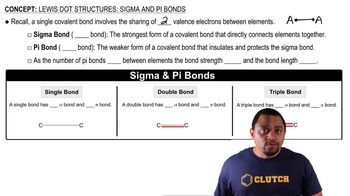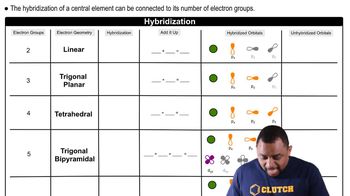An AB3 molecule is described as having a trigonal-bipyramidal electron-domain geometry. a. How many nonbonding domains are on atom A?
From their Lewis structures, determine the number of σ and π bonds in each of the following molecules or ions: (a) hydrazine, N2H4 (b) hydrogen cyanide, HCN (c) sulphur trioxide, SO3
 Verified step by step guidance
Verified step by step guidanceKey Concepts
Lewis Structures

Sigma (σ) and Pi (π) Bonds

Molecular Geometry and Hybridization

An AB3 molecule is described as having a trigonal-bipyramidal electron-domain geometry b. Based on the information given, which of the following is the molecular geometry of the molecule:
i. trigonal planar
ii. trigonal pyramidal
iii. T-shaped or
iv. tetrahedral?
Fill in the blank spaces in the following chart. If the molecule column is blank, find an example that fulfills the conditions of the rest of the row. Molecule Electron-Domain Hybridization Dipole Geometry of Central Atom Moment? Yes or No CO2 sp3 Yes sp3 No Trigonal planar No SF4 Octahedral No sp2 Yes Trigonal bipyramidal No XeF2
The lactic acid molecule, CH3CH(OH)COOH, gives sour milk its unpleasant, sour taste. e. What are the approximate bond angles around each carbon atom in the molecule?
An AB5 molecule adopts the geometry shown here. b. What is the electron-domain geometry for the molecule?
An AB5 molecule adopts the geometry shown here.
c. Suppose the B atoms are halogen atoms. Of which group in the periodic table is atom A a member:
i. group 5A
ii. group 6A
iii. group 7A
iv. group 8A, or
v. is more information needed?
